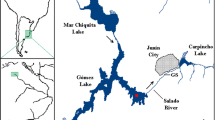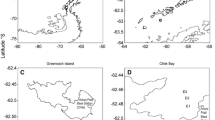Abstract
It is well documented that reduced visibility caused by elevated turbidity can affect feeding of fish, yet the extent to which selective zooplanktivory is altered in turbid conditions remains ambiguous. In this study, we examined the influence of natural sediment-induced turbidity on the overall prey consumption and selective predation of a common brackish water littoral zooplanktivore, the particulate feeding three-spined stickleback (Gasterosteus aculeatus L.). We hypothesized that the effects of turbidity on prey consumption and prey type selection would be pronounced due to the vision-oriented feeding of this species and that these effects would differ between genders. Using aquarium experiments with three different groups of cladocerans and copepods varying in size and behavior, we studied prey consumption and selectivity of this key planktivore in varying turbidity treatments. Our results indicated significantly decreased total prey consumption in the high turbidity treatments, as well as altered selective feeding on copepods and an enhanced preference for larger cladocerans. We found gender-dependent differences in prey consumption, which are consistent with observations of other visually feeding fish with sexual size dimorphism. We conclude that high turbidity, such as that occurring in shallow coastal areas, may affect selective feeding in vision-oriented zooplanktivores and that these effects may be gender-related.



Similar content being viewed by others
References
Bell MA, Foster SA (1994) The evolutionary biology of the threespine stickleback. Oxford University Press, USA
Benfield MC, Minello TJ (1996) Relative effects of turbidity and light intensity on reactive distance and feeding of an estuarine fish. Environ Biol Fish 46:211–216
Boehlert GW, Morgan JB (1985) Turbidity enhances feeding abilities of larval pacific herring, Clupea harengus pallasi. Hydrobiologia 123:161–170
Chesson J (1978) Measuring preference in selective predation. Ecology 59:211–215
Confer JL, Blades PI (1975) Omnivorous zooplankton and planktivorous fish. Limnol Oceanogr 20:571–579
Cronly-Dillon J, Sharma SC (1968) Effect of season and sex on the photopic spectral sensitivity of the three-spined stickleback. J Exp Biol 49:679–687
De Robertis A, Ryer CH, Veloza A, Brodeur RD (2003) Differential effects of turbidity on prey consumption of piscivorous and planktivorous fish. Can J Fish Aquat Sci 60:1517–1526
Drenner RW, Strickler JR, O’Brien WJ (1978) Capture probability: the role of zooplankter escape in the selective feeding of planktivorous fish. J Fish Res Board Can 35:1370–1373
Eggers DM (1977) The nature of prey selection by planktivorous fish. Ecology 58:46–59
Eriksson BK, Sieben K, Eklöf J, Ljunggren L, Olsson J, Casini M, Bergström U (2011) Effects of altered offshore food webs on coastal ecosystems emphasize the need for cross-ecosystem management. Ambio 40:786–797
Estlander S, Nurminen L, Olin M, Vinni M, Immonen S, Rask M, Ruuhijärvi J, Horppila J, Lehtonen H (2010) Diet shifts and food selection of perch Perca fluviatilis and roach Rutilus rutilus in humic lakes of varying water colour. J Fish Biol 77:241–256
Estlander S, Horppila J, Olin M, Vinni M, Lehtonen H, Rask M, Nurminen L (2012) Troubled by the humics—effects of water colour and interspecific competition on the feeding efficiency of planktivorous perch. Boreal Environ Res 17:305–312
Fontaine P, Gardeur JN, Kestemont P, Georges A (1997) Influence of feeding level on growth, intraspecific weight variability and sexual growth dimorphism of Eurasian perch Perca fluviatilis L. reared in a recirculation system. Aquaculture 157:1–9
Gardner MB (1981) Mechanisms of size selectivity by planktivorous fish: a test of hypotheses. Ecology 62:571–578
Gophen M, Drenner RW, Vinyard GL (1983) Cichlid stocking and the decline of the Galilee Saint Peter’s fish (Sarotherodon galilaeus) in Lake Kinneret, Israel. Can J Fish Aquat Sci 40:983–986
Gregory RS (1993) Effect of turbidity on the predator avoidance behaviour of juvenile Chinook salmon (Oncorhynchus tshawytscha). Can J Fish Aquat Sci 50:241–246
Hangelin C, Vuorinen I (1988) Food selection in juvenile three-spined sticklebacks studied in relation to size, abundance and biomass of prey. Hydrobiologia 157:169–177
Hayes JW, Rutledge MJ (1991) Relationship between turbidity and fish diets in Lakes Waahi and Whangape, New Zealand. N Z J Mar Fresh 25:297–304
Hemmings CC (1966) Factors influencing the visibility of objects underwater. In: Bainbridge R, Evans GC, Rackham O (eds) Light as an ecological factor. Blackwell Scientific Publications, Oxford, pp 359–374
Holtby LB, Healey MC (1990) Sex-specific life history tactics and risk taking in Coho salmon. Ecology 71:678–690
Horppila J, Nurminen L (2003) Effects of submerged macrophytes on sediment resuspension and internal phosphorus loading in Lake Hiidenvesi (southern Finland). Water Res 37:4468–4474
Horppila J, Nurminen L (2005) Effects of different macrophyte growth forms on sediment and P resuspension in a shallow lake. Hydrobiologia 545:167–175
Horppila J, Olin M, Vinni M, Estlander S, Nurminen L, Rask M, Ruuhijärvi J, Lehtonen H (2010) Perch production in forest lakes: the contribution of abiotic and biotic factors. Ecol Freshw Fish 19:257–266
Horppila J, Estlander S, Olin M, Pihlajamäki J, Vinni M, Nurminen L (2011) Gender-dependent effects of water quality and conspecific density on the feeding rate of fish—factors behind sexual growth dimorphism. Oikos 120:855–861
Jurvelius J, Leinikki J, Mamylov V, Pushkin S (1996) Stock assessment of pelagic three-spined stickleback (Gasterosteus aculeatus): a simultaneous up and down-looking echo-sounding study. Fish Res 27:227–241
Kiørboe T, Saiz E, Visser A (1999) Hydrodynamic signal perception in the copepod Acartia tonsa. Mar Ecol Prog Ser 179:97–111
Kirk JTO (1994) Light and photosynthesis in aquatic ecosystems, 2nd edn. Cambridge University Press, New York
Kitano J, Mori S, Peichel CL (2007) Sexual dimorphism in the external morphology of the threespine stickleback (Gasterosteus aculeatus). Copeia 2:336–349
Kohler CC, Ney JJ (1982) A comparison of methods for quantitative analysis of feeding selection of fishes. Environ Biol Fish 7:363–368
Lazzaro X (1987) A review of planktivorous fishes: their evolution, feeding behaviours, selectivities, and impacts. Hydrobiologia 146:97–167
Lehtiniemi M, Engström-Öst J, Viitasalo M (2005) Turbidity decreases anti-predator behaviour in pike larvae, Esox lucius. Environ Biol Fish 73:1–8
Lemmetyinen R, Mankki J (1975) The three-spined stickleback (Gasterosteus aculeatus) in the food chains of the northern Baltic. Merentutkimuslaitoksen Julk Havsforskningsinst Skr 239:155–161
Ljunggren L, Sandström A, Bergström U, Mattila J, Lappalainen A, Johansson G, Sundblad G, Casini M, Kaljuste O, Eriksson BK (2010) Recruitment failure of coastal predatory fish in the Baltic Sea coincident with an offshore ecosystem regime shift. ICES J Mar Sci 67:1587–1595
Lythgoe JN (1979) The ecology of vision. Clarendon Press, Oxford
Magnhagen C (1986) Activity differences influencing food selection in the marine fish Pomatoschistus microps. Can J Fish Aquat Sci 43:223–226
Mikheev VN, Wanzenböck J, Pasternak AF (2004) An interplay between foraging and antipredator behavior in 0 + perch (Perca fluviatilis) at the demersal phase. In: Barry TP, Malison JA (eds) Proceedings of Percis III: the third international percid fish symposium, pp 81–82
Miner JG, Stein RA (1993) Interactive influence of turbidity and light on larval bluegill (Lepomis macrochirus) foraging. Can J Fish Aquat Sci 50:781–788
Nassal B, Burghard W, Maier G (1998) Predation by juvenile roach on the calanoid copepod Eudiaptomus gracilis and the cyclopoid copepod Cyclops vicinus: a laboratory investigation with mixed and single prey. Aquat Ecol 32:335–340
Nurminen L, Horppila J (2006) Efficiency of fish feeding on plant-attached prey: effects of inorganic turbidity and plant-mediated changes in the light environment. Limnol Oceanogr 51:1550–1555
Nurminen L, Pekcan-Hekim Z, Repka S, Horppila J (2010a) Effect of prey type and inorganic turbidity on littoral predator-prey interactions in a shallow lake: an experimental approach. Hydrobiologia 646:209–214
Nurminen L, Pekcan-Hekim Z, Horppila J (2010b) Feeding efficiency of planktivorous perch (Perca fluviatilis) and roach (Rutilus rutilus) in varying turbidity: an individual-based approach. J Fish Biol 76:1848–1855
O’Keefe TC, Brewer MC, Dodson SI (1998) Swimming behavior of daphnia: its role in determining predation risk. J Plankton Res 20:973–984
Pekcan-Hekim Z, Lappalainen J (2006) Effects of clay turbidity and density of pikeperch (Sander lucioperca) larvae on predation by perch (Perca fluviatilis). Naturwissenschaften 93:356–359
Quesenberry N, Allen P, Cech J Jr (2007) The influence of turbidity on three-spined stickleback foraging. J Fish Biol 70:965–972
Radke RJ, Gaupisch A (2005) Effects of phytoplankton-induced turbidity on predation success of piscivorous Eurasian perch (Perca fluviatilis): possible implications for fish community structure in lakes. Naturwissenschaften 92:91–94
Reiriz L, Nicieza A, Brañta F (1998) Prey selection by experienced and naive juvenile Atlantic salmon. J Fish Biol 53:100–114
Rennie MD, Purchase CF, Lester N, Collins NC, Shuter BJ, Abrams PA (2008) Lazy males? Bioenergetic differences in energy acquisition and metabolism help to explain sexual size dimorphism in percids. J Anim Ecol 77:916–926
Rowe DK, Dean TL (1998) Effects of turbidity on the feeding ability of the juvenile migrant stage of six New Zealand freshwater fish species. N Z J Mar Fresh 32:21–29
Rowe DK, Dean TL, Williams E, Smith JP (2003) Effects of turbidity on the ability of juvenile rainbow trout, Oncorhynchus mykiss, to feed on limnetic and benthic prey in laboratory tanks. N Z J Mar Fresh 37:45–52
Salonen M, Engström-Öst J (2010) Prey capture of pike Esox lucius larvae in turbid water. J Fish Biol 76:2591–2596
Sanden P, Hakansson B (1996) Long-term trends in secchi depth in the Baltic Sea. Limnol Oceanogr 41:346–351
Shine R (1989) Ecological causes for the evolution of sexual dimorphism: a review of the evidence. Q Rev Biol 64:419–461
Smith C, Wootton R (1999) Parental energy expenditure of the male three-spined stickleback. J Fish Biol 54:1132–1136
Sundell J (1994) Dynamics and composition of littoral fish fauna along the coast of SW-Finland. Aqua Fennica 24:37–49
Utne-Palm A (2002) Visual feeding of fish in a turbid environment: physical and behavioural aspects. Mar Freshw Behav Physiol 35:111–128
Viitasalo M, Flinkman J, Viherluoto M (2001) Zooplanktivory in the Baltic Sea: a comparison of prey selectivity by Clupea harengus and Mysis mixta, with reference to prey escape reactions. Mar Ecol Prog Ser 216:191–200
Vinyard GL, O’brien WJ (1976) Effects of light and turbidity on the reactive distance of bluegill (Lepomis macrochirus). J Fish Res Board Can 33:2845–2849
Vinyard GL, Yuan AC (1996) Effects of turbidity on feeding rates of Lahontan cutthroat trout (Oncorhynchus clarki henshawi) and Lahontan redside shiner (Richardsonius egregius). West North Am Nat 56:157–161
Webster M, Atton N, Ward A, Hart P (2007) Turbidity and foraging rate in threespine sticklebacks: the importance of visual and chemical prey cues. Behaviour 144:1347–1360
Wong CK (1996) Response of copepods to hydromechanical stimuli. Crustaceana 69:853–859
Wootton RJ (1976) The biology of the sticklebacks. Academic Press, London
Wootton RJ (1984) A functional biology of sticklebacks. University of California Press, Berkeley
Acknowledgments
We wish to thank the staff at Tvärminne Zoological Station for providing excellent laboratory facilities and equipment, and R Vidal and Y Vatageot for valuable assistance. Walter and Andrée de Nottbeck Foundation (LH and JB) and Victoriastiftelsen (JB) are acknowledged for financial support. This study complies with current Finnish laws.
Author information
Authors and Affiliations
Corresponding author
Additional information
Handling Editor: Thomas Mehner.
Rights and permissions
About this article
Cite this article
Helenius, L.K., Borg, J.P.G., Nurminen, L. et al. The effects of turbidity on prey consumption and selection of zooplanktivorous Gasterosteus aculeatus L.. Aquat Ecol 47, 349–356 (2013). https://doi.org/10.1007/s10452-013-9448-x
Received:
Accepted:
Published:
Issue Date:
DOI: https://doi.org/10.1007/s10452-013-9448-x




